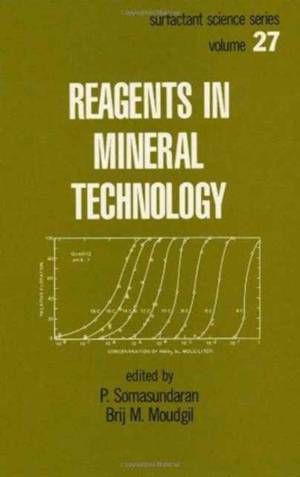
- Afhalen na 1 uur in een winkel met voorraad
- Gratis thuislevering in België vanaf € 30
- Ruim aanbod met 7 miljoen producten
- Afhalen na 1 uur in een winkel met voorraad
- Gratis thuislevering in België vanaf € 30
- Ruim aanbod met 7 miljoen producten
Zoeken
€ 635,45
+ 1270 punten
Omschrijving
Reagents in Mineral Technology provides comprehensive coverage of both basic as well asapplied aspects of reagents utilized in the minerals industry.This outstanding, single-source reference opens with an explicit account of flotation fundamentals, including coverage of wetting phenomena, mineral/water interfacial phenomena, flo tationchemistry, and flocculation and dispersion of mineral suspensions.It then discusses flotation of sulfide and nonsulfide minerals, with attention to formation ofclithiolates, formation of metal thiol compounds, application of fatty acids, sulfosuccinic acids, amines, and other collectors.Reagents in Mineral Technology also reviews adsorption of surfactants on minerals .. .details adsorption of polymers .. . and considers the chemistry and application of chelation agentsin minerals separations.Additional chapters consider grinding aids, frothers, inorganic and polymeric depressants, dewatering and filtering aids, analytical techniques, and much more.Unique in its depth of coverage, Reagents in Mineral Technology will prove an invaluablereference for mineral engineers and processors; analytical, surface, colloid, and physical chemists;petroleum, petrochemical, metallurgical, and mining engineers; and for use in advancedundergraduate- and graduate-level courses in these and related fields.
Specificaties
Betrokkenen
- Auteur(s):
- Uitgeverij:
Inhoud
- Aantal bladzijden:
- 772
- Taal:
- Engels
- Reeks:
- Reeksnummer:
- nr. 27
Eigenschappen
- Productcode (EAN):
- 9780824777159
- Verschijningsdatum:
- 1/08/1987
- Uitvoering:
- Hardcover
- Formaat:
- Genaaid
- Afmetingen:
- 156 mm x 234 mm
- Gewicht:
- 1247 g

Alleen bij Standaard Boekhandel
+ 1270 punten op je klantenkaart van Standaard Boekhandel
Beoordelingen
We publiceren alleen reviews die voldoen aan de voorwaarden voor reviews. Bekijk onze voorwaarden voor reviews.











